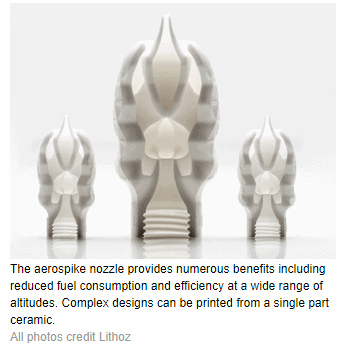Welcome to Sino Bearings web
24x7 HOTLINE:+86-28-81454188

 NEWS
NEWS
Aerospace is the second largest industry sector served by additive manufacturing (AM), after medicine, according to manufacturing technology advisory firm SmarTech. Yet there remains a lack of awareness about the potential of AM with ceramic materials to make aerospace components rapidly, with increased flexibility and cost effectiveness. AM offers faster and more sustainable production of stronger and lighter ceramic parts – reducing labor costs, minimizing manual assembly, and reducing the weight of aircraft via modelling-developed designs that improve efficiency and performance. Plus, AM ceramic technology offers dimension control in finished parts for features smaller than 100µm.
However, the word ceramic may conjure an incorrect idea of brittleness. In reality, AM ceramics create lighter, highly detailed components boasting huge structural strength, toughness, and resistance to vast temperature ranges. Forward-looking firms are turning to ceramics for components including nozzles and thrusters, electrical insulators, and turbine blades.
Materials
High-purity aluminum oxides, for example, offer high levels of hardness, allied to strong resistance to corrosion and temperature ranges. Components made from alumina are also electrically insulating at high temperatures often found in aerospace systems.
Zirconia-based ceramics satisfy many applications with extreme material demands coupled with high mechanical stress – such as high-end metal forming, valves, and bearings. Silicon nitride ceramics exhibit high strength, high toughness, and excellent thermal shock resistance, along with good chemical resistance to corrosion by many acids, alkalis, and molten metals. Silicon nitride is used in insulators, impellers, and high-temperature low-dielectric antennas.
Composite ceramics provide several desirable qualities. Silica-based ceramics with added alumina and zircon have proved outstanding for manufacturing single crystal casting of turbine blades. This is because ceramic cores made from this material have very low thermal expansion up to 1,500°C, high porosity, exceptional surface quality, and good leachability. Printing these cores enables production of turbine designs that can withstand higher operating temperatures and improve engine efficiency.
Benefits of AM ceramics
Injection molding or machining of ceramics is notoriously difficult, and machining provides limited access into a component being manufactured. Features such as thin walls are also difficult to machine.
Lithography-based Ceramic Manufacturing (LCM) used at Lithoz, however, enables manufacturing of precise, complex-shaped 3D ceramic components.
Starting with a CAD model, detailed specs are digitally transferred to the 3D printer. Precisely formulated ceramic-laced powder is then coated on top of a transparent vat. The movable building platform is dipped into the slurry, then selectively exposed to visible light from below. The layer image is generated via a digital micromirror device (DMD) coupled with a projection system. By repeating this process, a three-dimensional green part can be generated layer-by-layer. Following thermal post-processing, the binder is removed and the green parts are sintered – coalesced by a special heating process – resulting in fully dense ceramic components boasting outstanding mechanical properties and surface quality.
LCM technology provides an innovative, cost-efficient, and quicker process for investment casting of turbine engine components – bypassing costly and laborious fabrication of molds required in injection molding and lost-wax casting.
LCM can also realize designs that can’t be made any other way, while also using far less raw material than other methods.
Bridging the gap
Despite the huge potential of ceramic materials and LCM technology, a gap exists between AM original equipment manufacturers (OEMs) and aerospace designers.
One reason may be resistance to new manufacturing methods within a sector with particularly stringent safety and quality demands. Aerospace manufacturing requires many validation and qualification processes, with thorough, rigorous testing.
Another hurdle includes the perception that 3D printing is primarily suited only for one-off rapid prototyping rather than anything that can go into service in the air. Again, this is a misperception, with 3D-printed ceramic components already proven reliable for serial production.
One example is the manufacture of turbine blades, where AM ceramic processes produce cores for single crystals (SX), along with directionally solidified (DS) and equiax-cast (EX) super-alloy turbine blades. Cores with complex branching structures, multiple walls, and trailing edges smaller than 200µm can be produced quickly and economically, with the final components having consistent dimensional accuracy and excellent surface finish.
Greater communication can bring together aerospace designers and AM OEMs, with full trust in ceramic components made using technology such as LCM. The technology and expertise exist. It requires changing mindsets from AM for R&D and prototyping, to seeing it instead as a way forward for large-scale commercial applications.
As well as education, aerospace firms can invest time in people, engineering, and testing. Manufacturers must become familiar with differing standards and methods for evaluating ceramics, as opposed to metals. Two key ASTM standards used by Lithoz for structural ceramics, for example, are ASTM C1161 for strength testing, and ASTM C1421 for toughness. These standards are used for ceramics produced by all methods. In ceramic AM, the printing step is only a forming method, and the parts go through the same type of sintering as in conventional ceramics. Therefore, the microstructure of the ceramic parts will be very similar to conventional processing.
Where will we be in 10 years?
Based on ongoing advances in materials and technology, we can say with some confidence there will be much more data available for designers. New ceramic materials will be developed and tailored to specific engineering demands. Parts made with AM ceramics will have completed the qualification process for use in aerospace. And better design tools will be available, such as improved modeling software.
By collaborating with LCM technology experts, aerospace firms can bring AM ceramic processes in-house – shortening timelines, reducing costs, and opening opportunities to develop their company’s own intellectual property. With vision and long-term planning, aerospace firms investing in ceramic technology can reap major benefits across their production portfolio through the next decade and beyond.
By forming collaborative partnerships with AM ceramics companies, aerospace OEMs will produce components not previously imagined.